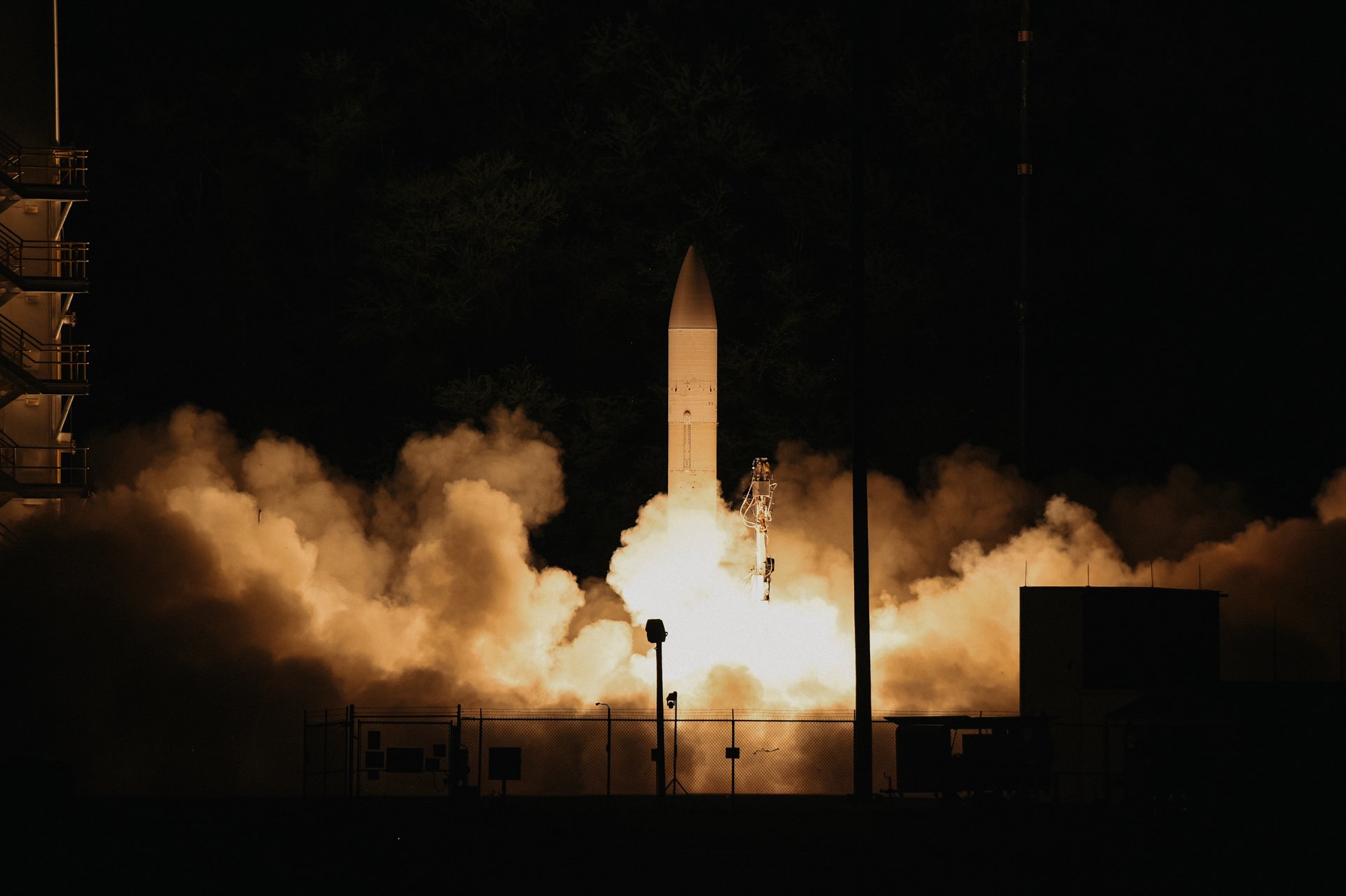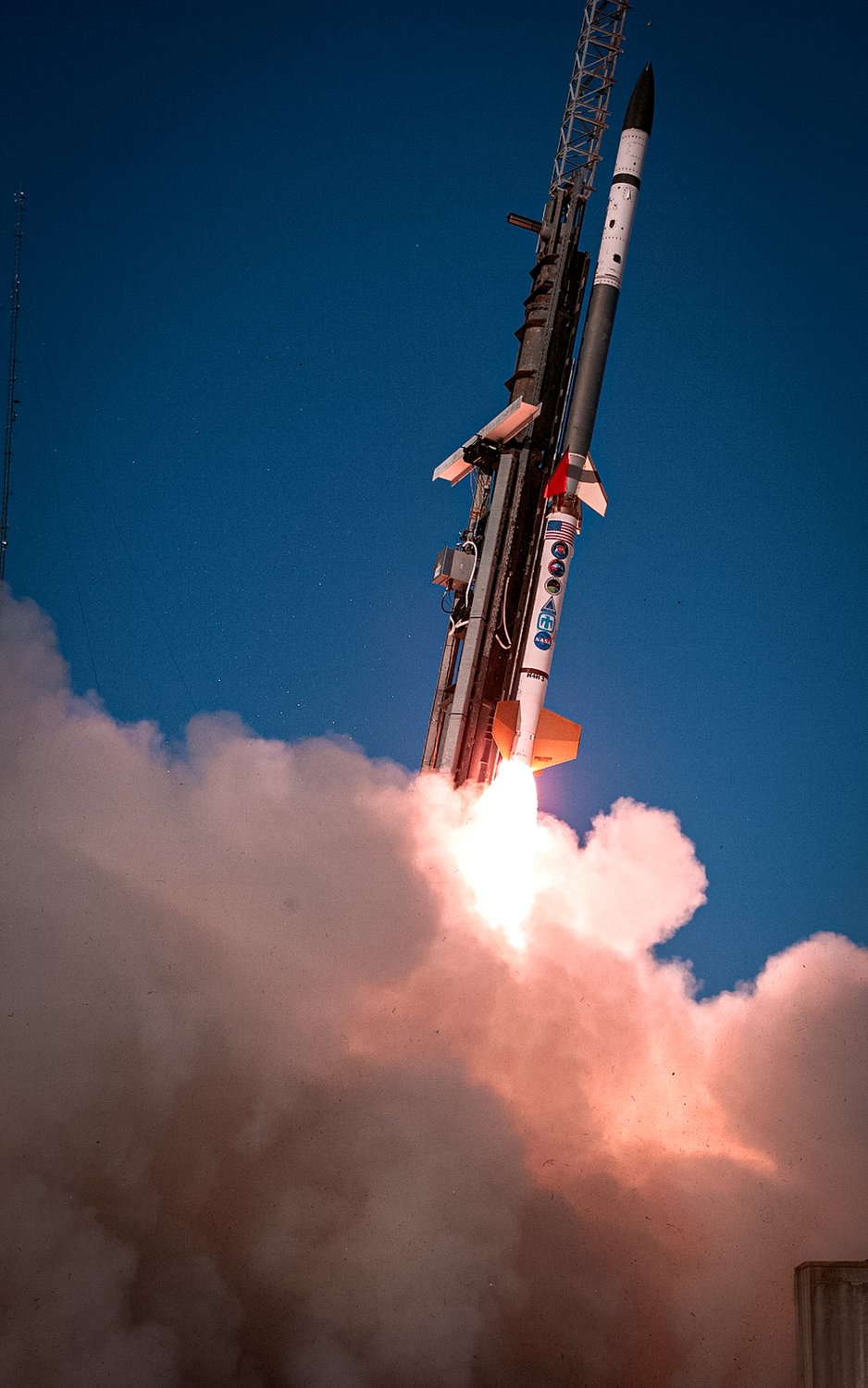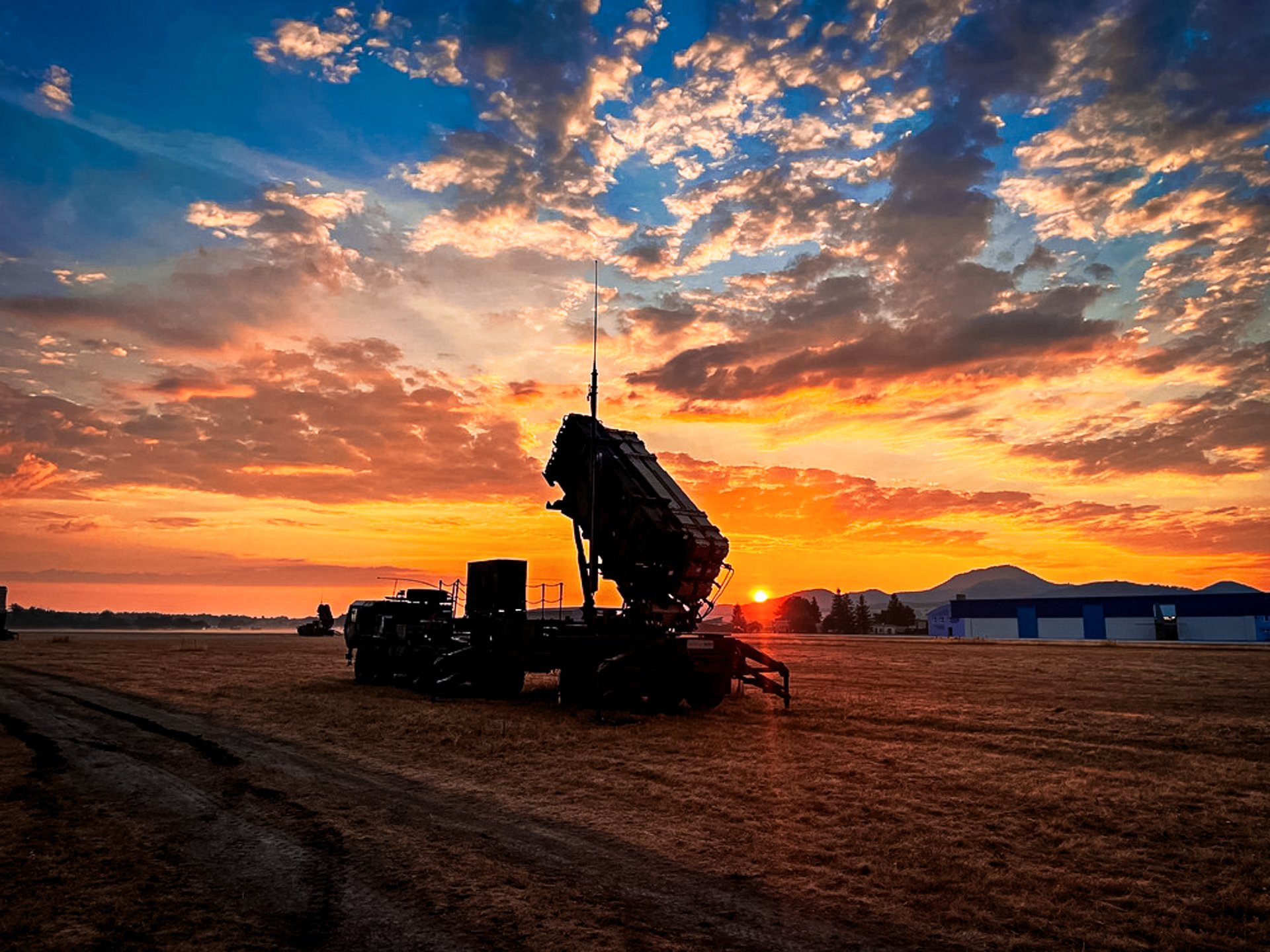Hypersonic Missiles Are the Future of Warfare, So Why Doesn’t the US Have Any?

A common hypersonic glide body (C-HGB) launches from Pacific Missile Range Facility, Kauai, Hawaii, at approximately 10:30 p.m. local time, March 19, 2020, during a Department of Defense flight experiment. The US Navy and US Army jointly executed the launch of the C-HGB, which flew at hypersonic speed to a designated impact point. Concurrently, the Missile Defense Agency (MDA) monitored and gathered tracking data from the flight experiment that will inform its ongoing development of systems designed to defend against adversary hypersonic weapons. Information gathered from this and future experiments will further inform DOD's hypersonic technology development. The department is working in collaboration with industry and academia to field hypersonic warfighting capabilities in the early- to mid-2020s. US Navy photo by Luke Lamborn.
Not many decades ago, the United States developed the atom bomb and emerged as the world’s foremost innovator of military weaponry. That is no longer the case, as protracted counterinsurgencies in Afghanistan and the Middle East have stunted the growth of America’s arsenal and left it lagging behind those of its near-peer adversaries. Perhaps the most glaring technological disparity is in the development of hypersonic missiles.
As of several years ago, Russia and China both possess hypersonic missiles. At the time of this writing, the US has none. Now, as the Global War on Terror is finally drawing to a close, the Pentagon is devoting huge amounts of money and manpower to catch up — and for good reason. Hypersonic missiles are vastly superior to all other long-range rockets. They are also, at least in theory, unstoppable by any defense systems that currently exist.
In fact, according to a Congressional Research Service in Focus report issued in May 2023, “U.S. defense officials have stated that both existing terrestrial- and space-based sensor architectures are insufficient to detect and track hypersonic weapons.”
For the American weapons engineers spearheading the hypersonic program, the challenge at hand is two-pronged. First, they must figure out how to make a missile that moves too fast and too unpredictably to be stopped by highly sophisticated air-defense systems. And then, what if, say, China or Russia solves that puzzle first? How do you counter a missile that can’t be stopped?
What Is a Hypersonic Missile?

US Navy Strategic Systems Programs and the Army Hypersonic Program Office conducting a High Operational Tempo for Hypersonics flight campaign. The test informed the development of the Navy’s Conventional Prompt Strike and the Army’s Long-Range Hypersonic Weapon offensive hypersonic strike capability. US Navy photo by Amy Smith.
The answer is tricky. By definition, “hypersonic” can be applied to any flying object that travels at or above five times the speed of sound (Mach 5). Weapons capable of moving that fast, such as conventional intercontinental ballistic missiles (ICBMs), have been around for decades.
Today, however, the term “hypersonic missile” is generally used to describe rockets that are not only extremely fast, but also extremely maneuverable. A technology officer in the aerospace industry, speaking on condition of anonymity, explained it to Coffee or Die this way: “ICBMs go high — once they fire in orbit, you can see its trajectory. Whereas a hypersonic missile is firing the whole time, so you can steer and shift and speed up and slow down.”
There are two types of hypersonic missiles: hypersonic glide missiles and hypersonic cruise missiles. Glide missiles are similar to ICBMs in that they are propelled by a high-velocity rocket booster and travel along a hyperbolic path. Unlike ICBMs, however, they do not leave the Earth’s atmosphere. And instead of free-falling in a fixed trajectory, their descent is controlled by a glide mechanism that allows them to be remotely piloted by operators on the ground.
A hypersonic cruise missile, on the other hand, is equipped with a propulsion system known as a scramjet (short for supersonic combustion ramjet). Scramjets require less fuel than what is needed to propel conventional rockets, as their combustion process is partially powered by air flowing through the engine at supersonic speeds. Because less fuel means less weight, a warhead propelled by a scramjet can move extremely fast — the current air-speed record for a hypersonic cruise missile is 9.6 times the speed of sound. The missile is designed to be fired from fast-moving aircraft at lower altitudes and travels along a horizontal — rather than a hyperbolic — flight path, which further reduces the time it takes to reach its target.
Technological Marvel or Mission: Impossible?

Artist’s concept of Hypersonic Air-Breathing Weapon Concept (HAWC) missile. Image courtesy of Raytheon Missiles & Defense.
Aerospace engineers working to develop hypersonic missiles have a number of unique variables to contend with, many of which stem from the extreme speeds at which the missiles travel through the atmosphere. At Mach 5 and above, the air at the nose of a flying object is pushed so hard that it ionizes, boiling the electrons off the atoms and generating plasma.
Plasma blocks infrared and radio waves. This makes it difficult for the computer systems on the missile to maintain communication with their human operators. Furthermore, the same chemical process that creates the plasma can also push temperatures upwards of more than 3,500° F. Very few materials can withstand that sort of heat, and those that exist are not available to the US — not yet, at least. At the moment, American aerospace engineers are working to develop ceramic composites and ceramic coatings that would allow hypersonic missiles to fly full speed without their physical integrity or communications systems being compromised. Until this particular issue is resolved, the risk of a hypersonic missile veering off-course or breaking apart mid-flight will remain high.
Speaking to Coffee or Die, Nigel Yoder, a former US Navy weapons officer who currently works as a program manager at BAE Systems, acknowledged that America’s aerospace industry is “playing catch-up” in the race to develop effective and reliable hypersonic weapons. Yet, he believes that American ingenuity and work ethic will ensure that the US ultimately prevails.
“If we get the gumption and we want to do it, we will and we can make up that ground in no time,” he says. “We have the best and the brightest, so whatever our armed forces and our strategic leaders need, we’re well equipped to deliver.”
In the Works: Hypersonic Missile Development in the US

A 3D illustration visualizing how a scramjet hypersonic weapon is deployed. Image by Travis Burcham for Airman Magazine.
Though the US currently has zero hypersonic missiles, the Pentagon’s fiscal year 2024 budget proposal indicates that the DOD expects to procure at least 24 of them in the near future.
“Any time you develop a capability, it puts on your adversary the requirement that they react to it or counter it,” Yoder said. “So there’s a lot of strategic implication to just having them. Twenty-four might be enough for someone to think twice.”
In 2021, the US Air Force and the Defense Advanced Research Projects Agency began collaborating on the development of a scramjet-powered cruise missile known as the Hypersonic Air-Breathing Weapon Concept (HAWC). The HAWC’s final test flight was successfully completed in January 2023, when it was launched from a B-52 bomber and flew at speeds greater than Mach 5 over a distance of more than 300 nautical miles — a major improvement from the missile’s performance in previous tests.
The Pentagon’s efforts to build a hypersonic arsenal don’t stop there. Last September, the Air Force awarded Raytheon and Northrop Grumman a $985 million contract to develop a new scramjet-propelled rocket it is calling the Hypersonic Attack Cruise Missile (HACM).

The most cutting-edge hypersonics currently being developed are built around scramjets, which use the air flowing through the engine to create combustion. Removing the need for an engine to carry its own supply of liquid oxygen makes the craft smaller, lighter, and faster. Infographic via NASA.
Meanwhile, Zumwalt-class destroyers are expected to carry Navy Conventional Prompt Strike (CPS) missiles and Army Long-Range Hypersonic Weapons (LRHW) by 2025. And Virginia-class submarines are expected to carry both by 2029. Although, according to the Pentagon’s director of operational test and evaluation, Nickolas Guertin, the operational capability of the CPS missile has yet to be demonstrated.
Hypersonic Weapons Worldwide
Russia claims to be the first country in the world to have successfully fired a hypersonic missile. According to Moscow, the landmark event took place on March 18, 2022, when a Russian-fired Kh-47M2 Kinzhal missile destroyed an underground weapons depot in the Ukrainian village of Deliatyn. Since then, Russia has deployed Kinzhals on multiple occasions, resulting in dozens of casualties.
However, some experts have disputed the classification of the Kinzhal as hypersonic, on the grounds that it only travels at hypersonic speeds during portions of its flight. And, in fact, while Kinzahls are more maneuverable than ICBMs, they are not technologically on par with hypersonic glide missiles and cruise missiles.
While Kinzhals are not technically hypersonic, Russia did indeed add a legitimate nuclear-armed hypersonic glide missile to its arsenal in 2019. Known as the Avanguard missile, the weapon purportedly reaches a top speed of more than Mach 20 (roughly 13,000 mph) and has a range of more than 3,700 miles.

Russian MiG-31 carrying a Kh-47M2 Kinzhal hypersonic missile. Russian Ministry of Defense photo.
More recently, in January 2023, Russian President Vladimir Putin announced that a Russian frigate armed with a new hypersonic “Zircon” cruise missile had set course for the Atlantic Ocean. Putin claimed the weapon has “no analogues in any country in the world.” According to Russian Defense Minister Sergei Shoigu, the Zircon travels at speeds of up to Mach 9 and has a range of more than 620 miles. (None of these claims have been independently verified.)
China, meanwhile, has an even more diverse arsenal of hypersonic weapons. They include the DF-17 medium-range ballistic missile, the DF-41 ICBM, and the DF-ZF hypersonic glide missile, which has a range of 1,200 miles. The Chinese have also built a nuclear-capable prototype of the DF-ZF, called the Starry Sky-2.
In February, China successfully tested a new hypersonic glide missile. According to leaked US military documents, the new missile, called the DF-27, successfully traveled 1,300 miles in under 12 minutes. A 2021 DOD report indicated that the DF-27 could possibly have a range of nearly 5,000 miles. If true, that would give China the ability to launch devastating strikes on US military targets in Japan, Guam, and possibly even Hawaii.
Iran has now also apparently joined the hypersonic arms race. In June 2023, Iranian state television broadcasted the announcement of a new missile called “Fattah,” which means “Conqueror” in Farsi.

Kyiv mayor Vitali Klitschko stands in front of the remnants of a purported Russian Kinzhal missile shot down by a Patriot defense system in May. Screenshot from @KyivCityOfficial Telegram account.
“There exists no system that can rival or counter this missile,” said Gen. Amir Ali Hajizadeh, head of the Iranian Revolutionary Guard’s aerospace program.
Hajizadeh claimed the Fattah can travel 15 times the speed of sound at a range of up to 870 miles. However, Iranian officials did not release any footage of a successful launch or target strike, only saying that there had been a ground test of the engine.
Are Hypersonics Unstoppable?
On the night of May 4, Ukrainian forces used a newly delivered Patriot missile defense system to shoot a Russian Kinzhal out of the sky near Kyiv.
“Congratulations to the Ukrainian people on a historic event,” Ukrainian Air Force commander Mykola Oleshchuk proclaimed via telegram on May 6. “Yes, we brought down the ‘unparalleled’ Kinzhal!”

The sun rises over a 10th AAMDC Patriot missile launcher in Slovakia. US Army photo by 2nd Lt. Emily Park.
At a press conference held soon after, US Defense Department press secretary Brig. Gen. Pat Ryder said that the Pentagon had confirmed Oleshchuk’s claims. Three days later, Ukraine announced that it shot down six more Kinzhals — though that claim is in dispute, as Russian Defense Minister Sergei Shoigu responded to it by saying that his military had not fired six Kinzhals at Kyiv that day.
While the Patriot’s success at downing Kinzhal missiles is impressive, it is important to remember that the rocket is neither a hypersonic cruise missile nor a hypersonic glide missile. Currently, no missile defense system exists that is known to be capable of defeating those two types of weapons. The race is on to develop one.
In 2020, the US government contracted SpaceX to build satellites that can track hypersonic missiles. Then, in 2022, the Space Development Agency awarded $1.3 billion in contracts to both L3Harris Technologies and Northrop Grumman Strategic Space Systems to also begin developing missile tracking satellite systems.
Additionally, the US Navy has partnered with Raytheon on a program to develop anti-hypersonic missile capabilities. The goal of the program is to use existing defense systems mounted on Aegis cruisers to target hypersonic missiles during the long glide phase that follows a launch.
Read Next: SR-71 Blackbird: The Spy Plane That Could Outrun Missiles

Maggie BenZvi is a contributing editor for Coffee or Die. She holds a bachelor’s degree in political science from the University of Chicago and a master’s degree in human rights from Columbia University, and has worked for the ACLU as well as the International Rescue Committee. She has also completed a summer journalism program at Northwestern University’s Medill School of Journalism. In addition to her work at Coffee or Die, she’s a stay-at-home mom and, notably, does not drink coffee. Got a tip? Get in touch!
BRCC and Bad Moon Print Press team up for an exclusive, limited-edition T-shirt design!
BRCC partners with Team Room Design for an exclusive T-shirt release!
Thirty Seconds Out has partnered with BRCC for an exclusive shirt design invoking the God of Winter.
Lucas O'Hara of Grizzly Forge has teamed up with BRCC for a badass, exclusive Shirt Club T-shirt design featuring his most popular knife and tiomahawk.
Coffee or Die sits down with one of the graphic designers behind Black Rifle Coffee's signature look and vibe.
Biden will award the Medal of Honor to a Vietnam War Army helicopter pilot who risked his life to save a reconnaissance team from almost certain death.
Ever wonder how much Jack Mandaville would f*ck sh*t up if he went back in time? The American Revolution didn't even see him coming.
A nearly 200-year-old West Point time capsule that at first appeared to yield little more than dust contains hidden treasure, the US Military Academy said.












